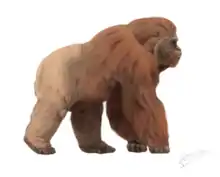Kapi ramnagarensis
Kapi is an extinct genus of gibbons that lived about 13.8 to 12.5 million years ago during the Miocene.[1] The type species is K. ramnagarensis and it is known from a complete lower molar.[1]
| Kapi ramnagarensis Temporal range: Miocene, | |
|---|---|
| Scientific classification | |
| Kingdom: | Animalia |
| Phylum: | Chordata |
| Class: | Mammalia |
| Order: | Primates |
| Suborder: | Haplorhini |
| Infraorder: | Simiiformes |
| Family: | Hylobatidae |
| Genus: | †Kapi Gilbert et al., 2020 |
| Species: | †K. ramnagarensis |
| Binomial name | |
| †Kapi ramnagarensis Gilbert et al., 2020 | |
The holotype molar was discovered in 2015 in the Lower Siwaliks of Ramnagar in Jammu and Kashmir. On 8 September 2020, scientists in northern India described the fossil and named the new species K. ramnagarensis.[1][2]
The generic name Kapi is from the Hindi term for a monkey. The specific name is after Ramnagar, where the type specimen was first found.[1]
References
- Gilbert, Christopher C.; et al. (9 September 2020). "New Middle Miocene Ape (Primates: Hylobatidae) from Ramnagar, India fills major gaps in the hominoid fossil record". Proceedings of the Royal Society B. 287 (1934). doi:10.1098/rspb.2020.1655. PMC 7542791. PMID 32900315. S2CID 221538516.
- Bower, Bruce (8 September 2020). "A stray molar is the oldest known fossil from an ancient gibbon - Ancestors of these small-bodied apes were in India roughly 13 million years ago, a study suggests". Science News. Retrieved 8 September 2020.
This article is issued from Wikipedia. The text is licensed under Creative Commons - Attribution - Sharealike. Additional terms may apply for the media files.



